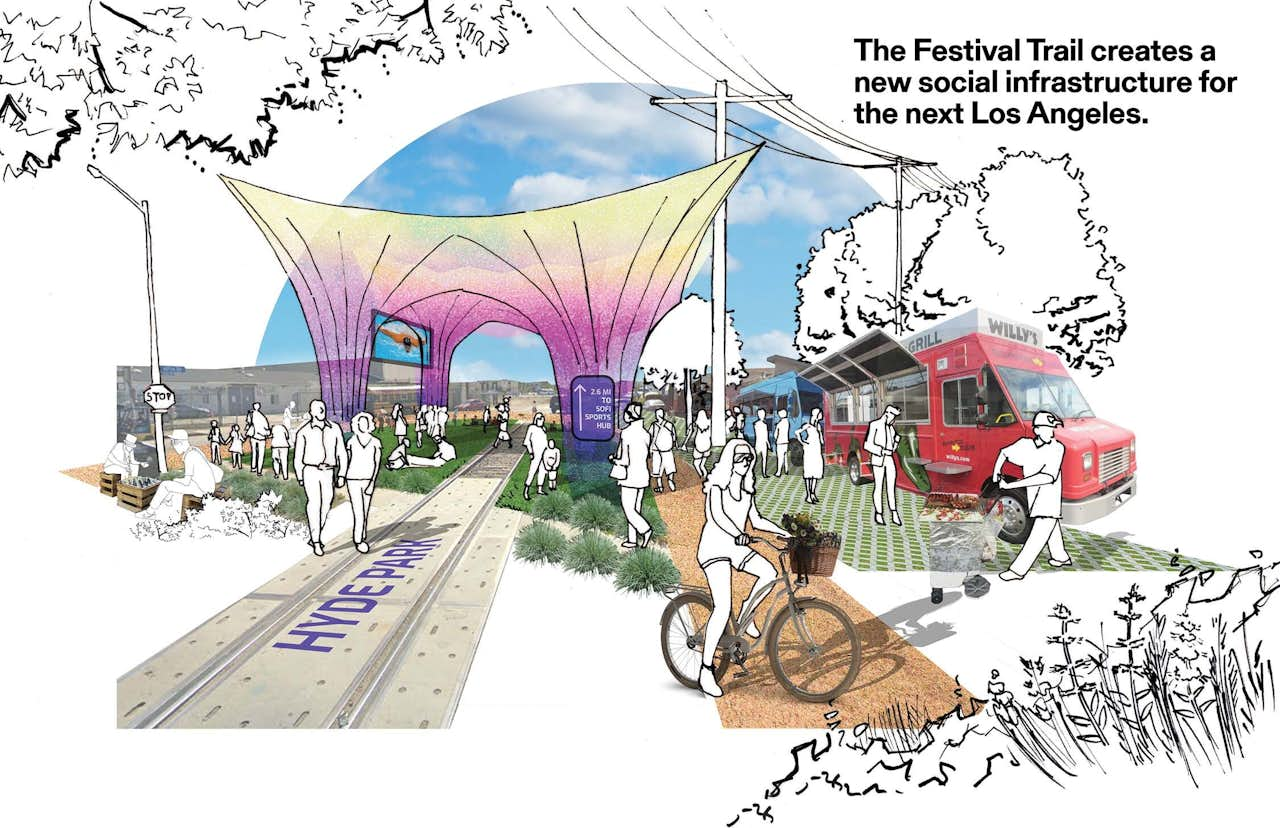Has anyone heard of the "Festival Trail"? I have not, this is the first time I'm hearing about it. It's mentioned and linked in the following article:
From dwell.com:
Can L.A. Really Pull Off a “Car-Free” Olympics?
Ahead of the 2028 games, the city has set ambitious transportation goals that could forever transform how Angelenos get around.
Text by Alissa Walker
While some will watch the Summer Olympics to see how many gold medals end up around gymnast Simone Biles’s neck, others will tune in for glimpses of a different type of win: Paris’s astounding transition away from cars in the years leading up to the games. After her election in 2014, Mayor Anne Hidalgo used the 2024 Olympics to accelerate a transportation revolution that kicked vehicular traffic off major thoroughfares, expanded the region’s Metro system, built 600 miles of bike lanes, planted 65,000 trees, and created over 200 pedestrian plazas outside schools.
The result is a Paris where residents overwhelmingly opt for other modes of transportation over cars; Over the last two decades, car traffic has fallen 50 percent, and so have injury crashes and air pollution. (And, as some in Paris have noted, the infrastructure updates have made it easier to weave through unpredictable games-related closures.) Throughout the French capital, the change is tangible: cacophonous corridors replaced with quieter and safer streets, glaring pavement swapped with shady green microforests.
In August, the baton will be handed to Los Angeles, host of the 2028 Summer Olympic and Paralympic Games. L.A. has hosted the games two times before, and the city has built a civic identity around being ready to leverage the risk of a megaevent that’s thrown dozens of other cities into crisis. In 2017, when Paris and L.A. were awarded their games simultaneously, Hidalgo and former L.A. mayor Eric Garcetti signed an agreement to align their climate goals leading up to the events. But seven years later, it’s becoming increasingly unclear if L.A. can deliver part of its 2028 Olympics promise: to produce what planners have dubbed the "car-free games."
The declaration is a practical one: There’s no parking at venues due to security perimeters, so games-goers will have to largely do without cars to traverse a 500 square-mile region. This is, of course, already the reality for many Angelenos; Metro, L.A.’s transit authority, serves nearly one million people daily. But the city’s wide, dangerous, and perpetually clogged streets make getting around very difficult without a car—let alone with 10 million Olympics ticketholders moving around town. Which may explain a recent messaging shift by some officials, who are now calling them "transit-first" games, signifying an attempt to (slightly) walk back the "car-free" commitment.
To achieve a "car-free games" in L.A., two things need to happen: "Reduce car space, and increase investment in non-car modes," says Yonah Freemark, principal research associate in the Metropolitan Housing and Communities Policy Center at the Urban Institute, who has studied Paris’s reduction in car use. Leaders haven’t carved out more room for sidewalks, bike lanes, and plazas, he says, which is what L.A. needs to work on most. "L.A. is just not designed for the same level of walkability," says Freemark. "There hasn’t been enough work to ensure the streets are safe and comfortable for pedestrians and bikers."
L.A. is delivering on other sustainability aspects of its bid. The LA28 organizing committee promised the "radical reuse" of existing facilities: venues are being privately funded, at no costs to taxpayers, and hopefully, leveraged to turn a profit, like organizers famously did in 1984. (Although L.A. is fudging a little by allocating $54 million in public money to a convention center renovation.) Classic venues will be back in rotation, including the L.A. Memorial Coliseum (used in both the 1984 and 1932 games), Dodger Stadium, and the Rose Bowl in Pasadena; with newer billionaire-bankrolled venues in adjacent Inglewood (SoFi Stadium and the Intuit Dome) added to the mix. "We are going to deliver the right games for L.A., not change L.A. to fit the games," LA28 chairperson Casey Wasserman said in July. LA28 is applying such a light touch to L.A.’s built environment that it won’t be erecting temporary facilities for softball and canoe slalom—these events will be held will be held in Oklahoma City.
The transportation plan is a different story. In 2018, Metro’s board of directors approved Twenty-Eight by ’28, a list of 28 major transportation projects to be accelerated in advance of the games that will serve as the ultimate legacy improvements for everyday commuters. In April, L.A. Mayor and Metro board member Karen Bass touted the latest $900 million in federal dollars awarded for games-related transit infrastructure. "I look forward to more accessibility and easier travel for Metro’s current riders and for future riders, as we continue preparing to be on the world stage," she said. It’s still not quite enough funding; six years later, only a handful of the original 28 projects are complete. Some are on track for 2028, like a people mover connection from LAX to the K and C lines, and the completion of the D line subway to Westwood, where athletes will stay on the UCLA campus.
[...]
 A rendering of the Festival Trail.
A rendering of the Festival Trail.
 The Festival Trail proposes a non-vehicular network to connect various venues for the 2028 L.A. Olympics.
The Festival Trail
The Festival Trail proposes a non-vehicular network to connect various venues for the 2028 L.A. Olympics.
The Festival Trail



